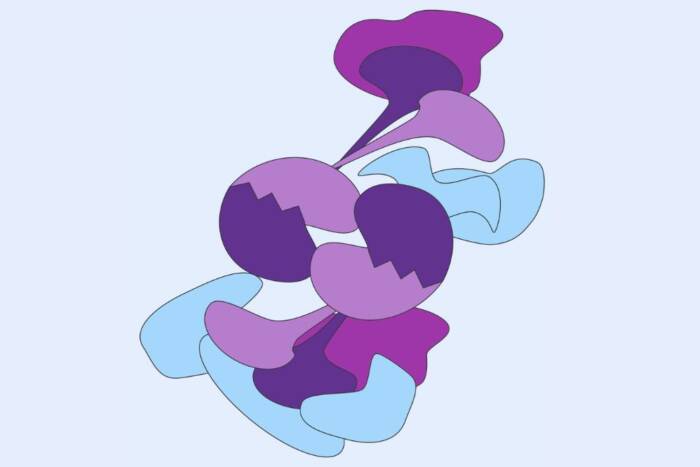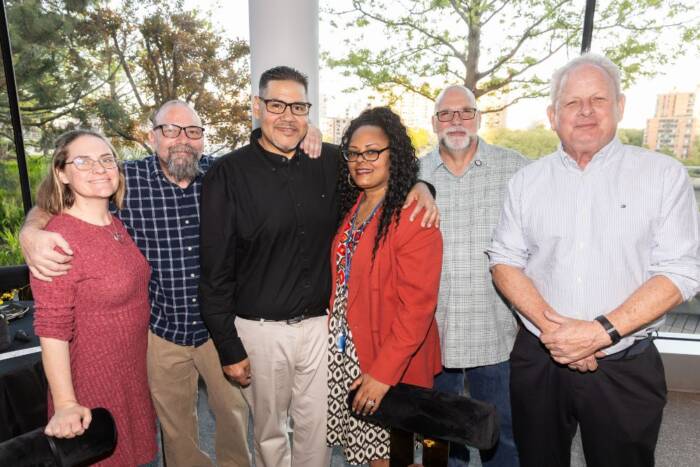Rick Lifton, geneticist who linked salt and hypertension, to be Rockefeller’s 11th president
by Zach Veilleux, director of publications & editor-in-chief
Rick Lifton has been at the cutting edge of genomics since his college days and has led Yale’s department of genetics for the last 18 years. He’s also the scientist whose work makes us feel guilty about sprinkling salt on our fries.
An internationally recognized physician-scientist, Richard P. Lifton, 62, was named Rockefeller’s 11th president on May 5 and will take office on September 1. What he is best known for—which anyone who googles him will soon learn—is discovering the connection between salt and high blood pressure. It is a topic that had been hotly debated for decades, with large-scale population studies of salt intake and hypertension never quite resulting in definitive guidelines. Dr. Lifton’s work identified the specific genes that drive blood pressure to high or low extremes, and pinpointed the kidney’s role in regulating salt in the body.
The research provided the scientific underpinning for public health efforts to prevent the development of hypertension by, among other things, encouraging the reduction of salt in the diet. It also led to helpful new information about how hypertension can be treated, using combinations of existing drugs and suggesting new targets for the development of future therapeutics.
But for scientists, the real story beneath Dr. Lifton’s discovery isn’t just about salt and hypertension and public health. It’s about the use of genetics to solve biological mysteries, and ultimately about the power of basic science.
It’s his commitment to this mission—to bridge the study of cells, genes, and molecules with the development of medicine—along with his experience and leadership on a national stage that led the 12-person presidential search committee to select him as Rockefeller’s next president.
Science for the benefit of medicine
Dr. Lifton was born in Washington, D.C., the son of an Air Force physician who was involved in the early days of the space program. He moved throughout his childhood, both within the U.S. and internationally. Inspired in part by his father, he pursued medicine and science as a student at Dartmouth College.
It was in this early phase of his training that he first started to marry medicine with basic science.
“At Dartmouth, the idea of trying to understand the fundamental causes of disease using basic science approaches struck me as an obvious thing to be doing,” Dr. Lifton says. “As I started looking into medicine as a career I was struck by how little we understood about how many diseases arise. This has really left us flying blind in trying to effectively prevent or treat them.”
After graduation he enrolled in Stanford University’s M.D.-Ph.D. program, where recombinant DNA technology—enabling the isolation of individual pieces of genomes of any species by cloning them in bacteria—had just been invented. “It didn’t take much imagination to realize that this was going to transform the way we understood basic biology and human health,” Dr. Lifton recalls. In his graduate work, collaborating with Michael Goldberg and Robert Karp in David Hogness’ laboratory, he characterized the genes encoding the fruit fly histone genes, resulting in discovery of the TATA box, a common DNA sequence that plays an important role in initiating gene expression in eukaryotic cells.
During the four-year period in which he completed his medical training at Brigham and Women’s Hospital in Boston, it became clear that the work he had been doing at Stanford, in Drosophila, could be extended to human biology. He accepted his first faculty position at Harvard Medical School in 1991, and moved to Yale in 1993.
“Once it had been shown that one could find rare single gene mutations that drastically altered development in fruit flies, it seemed compelling that one might take an analogous approach to vexing human diseases, and systematically search for rare mutations that cause these diseases, gaining insight into pathways that might be manipulated for disease prevention or treatment,” says Dr. Lifton.
The hypertension experiment that he would become widely known for is a classic example. It works by focusing on people who naturally have very high or very low blood pressure, right on the edge of what is survivable. The researchers then look for genes that are mutated in these people but not others. Once they’ve figured out what genes are driving variations in blood pressure, they are able to determine the molecular mechanisms that link these genes to human biology. In the case of hypertension, mutations in more than 20 genes have shown that increased or decreased salt reabsorption by the kidney drives blood pressure to extremely high or low levels, respectively.
The same process can be applied to a wide variety of traits and conditions. In 2009, Dr. Lifton’s lab perfected methods for rapidly and inexpensively sequencing all 20,000 genes in the human genome, ushering in an explosive phase of human genetic discovery. “At that time, we knew what happened in humans when about 3,000 genes were mutated, but were left wondering if there would be consequences of mutation for the remainder,” Dr. Lifton says. “These genome-level sequencing methods have allowed us to determine that mutation of a very large number of additional genes causes distinctive traits or diseases.”
In recent years, Dr. Lifton’s lab has used these methods to identify mutations underlying cardiovascular disease, neoplasia, kidney disease, neuropsychiatric disease, and osteoporosis, to name a few.
“This work outlines a path to understand the consequence of mutation of every gene in the human genome,” Dr. Lifton says. “This will set the stage for defining the gene products and pathways that can be manipulated for disease prevention and therapy. I’m a proselytizer for using genetics to solve the problems that haven’t yielded to other approaches.”
An opportunity to lead
Five years after joining Yale, Dr. Lifton was named chair of the department of genetics. It’s a position he has held for the past 18 years. In 2009 he founded the Yale Center for Genome Analysis, and has served as its executive director for the past seven years.
“I’ve had the opportunity to recruit spectacular faculty, as well as develop a human genetics program that extends into almost every clinical department at Yale,” he says.
He has also developed a reputation well beyond New Haven. He has been a Howard Hughes Medical Institute investigator since 1994, is a member of the National Academy of Sciences and the National Academy of Medicine, and has served on a number of NIH panels, including serving as co-chair of the working group responsible for planning the White House/NIH Precision Medicine Initiative. Technology he has developed has been put into wide use, and he has advised or collaborated with scientists all over the world, including many at Rockefeller.
“Rick’s innovative and effective leadership of the Yale programs in genetics led to enormous improvements in the speed and accuracy of DNA sequencing while simultaneously dramatically reducing the costs,” says Barry Coller, Rockefeller’s vice president for medical affairs and physician-in-chief of The Rockefeller University Hospital. “Equally important has been his encouragement and support of his colleagues to employ the most advanced techniques to define the genetic contributions to disease. His extraordinary expertise and experience will enormously enrich our research programs in human genetics.”
When President Marc Tessier-Lavigne announced his departure for Stanford in February, Dr. Lifton’s name emerged quickly among the panel of four faculty members and nine trustees who formed the presidential search committee.
“Rick is a distinguished scientist in his own right, and he also has a general scientific knowledge that is both broad and deep,” says Russell L. Carson, chairman of Rockefeller’s Board of Trustees and head of the search committee. “In our conversations it also became clear that he has extraordinary leadership skills, including a unique blend of diplomacy, authenticity, and warmth that we felt would make him a truly superb leader for this institution. He also has a deep understanding of Rockefeller’s mission and culture, and strong commitment to diversity.”
“He’s one of the most broadly knowledgeable and forward thinking people I know,” agrees Jeffrey M. Friedman, head of the Laboratory of Molecular Genetics(opens in new window), who has known him for years. “He has absolutely fantastic judgment. He has played important leadership roles at Yale and in the NIH and has served as an advisor in the pharmaceutical industry. Over and over again, for very good reasons, large numbers of important and smart people have relied on him for his advice, and I’m absolutely thrilled that he will be coming to lead Rockefeller.”
Dr. Lifton will become president at a time when Rockefeller is in the midst of a dramatic campus extension project, is ahead of schedule on its ambitious nine-year fundraising campaign, and has a strong faculty recruitment program that has yielded seven new faculty members in two years. He will move his lab to Rockefeller over the summer, continuing a longstanding Rockefeller tradition of presidents maintaining active research programs. He will also take a seat on the Board of Directors of the New York Genome Center.
He will move to New York City with his wife, Debbie, who is trained as a nurse. Their three children, Nathan, Jessica, and Christine, are grown: one is in college, one in medical school, and the third works in San Francisco.
“The opportunity at Rockefeller is extraordinary on so many fronts,” Dr. Lifton says. “The focus on science here is unique, the clarity of purpose and the mission—science for the benefit of humanity—speak to me in a profound way, and the opportunity to work with a brilliant, intellectually diverse group of colleagues is fantastic. I’m excited about the developments that are taking place at Rockefeller at this moment. I think the environment here is perfect for developing a deep relationship between innovation, basic biology, and understanding human health and disease.”



